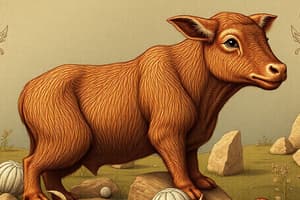Podcast
Questions and Answers
What condition is characterized by posterior paralysis in animals?
What condition is characterized by posterior paralysis in animals?
- Rickets (correct)
- Pica
- Grass tetany
- Milk fever
Which mineral is particularly important for the proper functioning of thyroid hormones?
Which mineral is particularly important for the proper functioning of thyroid hormones?
- Potassium
- Magnesium
- Iodine (correct)
- Calcium
What are inorganic elements essential for animal nutrition commonly referred to as?
What are inorganic elements essential for animal nutrition commonly referred to as?
- Minerals (correct)
- Organic compounds
- Biochemical elements
- Nutritional minerals
Which mineral deficiency is primarily linked to poor growth and infertility in animals?
Which mineral deficiency is primarily linked to poor growth and infertility in animals?
What is the primary symptom of magnesium deficiency in animals?
What is the primary symptom of magnesium deficiency in animals?
What condition in pigs is linked to zinc deficiency?
What condition in pigs is linked to zinc deficiency?
What is the primary role of macro minerals in animal nutrition?
What is the primary role of macro minerals in animal nutrition?
What is the correct calcium to phosphorus ratio in monogastrics?
What is the correct calcium to phosphorus ratio in monogastrics?
Which mineral is crucial for the synthesis of vitamin B12 in ruminants?
Which mineral is crucial for the synthesis of vitamin B12 in ruminants?
What is a key symptom of iron deficiency in animals?
What is a key symptom of iron deficiency in animals?
Which of the following is NOT a function of minerals in animal tissues?
Which of the following is NOT a function of minerals in animal tissues?
Micro minerals are required in what form for animal nutrition?
Micro minerals are required in what form for animal nutrition?
What disorder in chicks is characterized by slipped tendons?
What disorder in chicks is characterized by slipped tendons?
Which of the following is associated with emaciation in cattle and sheep?
Which of the following is associated with emaciation in cattle and sheep?
What common deficiency symptom can occur from a lack of calcium in animals?
What common deficiency symptom can occur from a lack of calcium in animals?
Which mineral is primarily responsible for the maintenance of ionic equilibrium in the body?
Which mineral is primarily responsible for the maintenance of ionic equilibrium in the body?
Flashcards are hidden until you start studying
Study Notes
Minerals
- Minerals are essential for animal nutrition and are considered inorganic elements.
- They are found in the ash fraction of feed, required in varying amounts.
- Animals obtain minerals from feed, mineral supplements, drinking water, and soil (accidentally or intentionally).
Gross Chemical Composition of Plant and Animal Tissue
- The chart illustrates the percentage composition of plant and animal tissue across different components.
- It highlights the significant presence of water, organic matter, and ash (minerals) in both plant and animal tissue.
Functions of Minerals
- Structural components:
- Minerals are constituents of skeletal structures, providing bones and teeth with rigidity and strength.
- Bones contain over 80% inorganic salts.
- They also form organic compounds like proteins and lipids, found in muscles, organs, and blood cells.
- Ionic equilibrium:
- Minerals maintain ionic balance in the body, with elements like Mg², Cl, and SO₄ playing roles.
- Enzyme activation:
- Minerals activate enzymes, with examples like cytochrome oxidase (Cu) and sodium (Na) and phosphorus (P) being activators.
- Hormones:
- Minerals like iodine (I) are components of hormones and are incorporated into their structures.
- Vitamin activation:
- Minerals like cobalt (Co) are essential for microorganism production of vitamin B₁₂.
- Acid-base equilibrium:
- Minerals contribute to acid-base balance through excretion of H ions.
- Nerve excitability:
- Minerals play a role in nerve excitability.
Mineral Classification
- Macrominerals: Required in relatively large amounts, usually expressed as a percentage.
- Examples: calcium (Ca), phosphorus (P), potassium (K), sodium (Na), chlorine (Cl), magnesium (Mg), and sulfur (S).
- Microminerals: Required in trace amounts, expressed as parts per million (ppm), mg/lb, or mg/kg.
- Examples: iron (Fe), copper (Cu), cobalt (Co), iodine (I), molybdenum (Mo), fluorine (F), manganese (Mn), zinc (Zn), and selenium (Se).
Calcium
- Calcium is closely linked to phosphorus in metabolism and accounts for 70% of the ash in the body.
- Ideal Ca:P ratio:
- Monogastrics: 1-2:1
- Ruminants: 7:1
- Laying hens: 10:1
Specific Mineral Deficiency Symptoms
- Calcium: Osteoporosis, milk fever in cows, and rickets.
- Milk fever: characterized by cows turning their heads towards their flanks after parturition.
- Rickets: characterized by posterior paralysis.
- Phosphorus: Pica, poor growth, infertility.
- Pica: abnormal eating behavior observed in animals.
- Magnesium: Hypomagnesemia (grass tetany).
- Grass tetany: caused by grazing lush greens low in Mg, high in K and N, interfering with digestion, resulting in stiff muscles, inability to stand, and eventually death.
- Zinc: Parakeratosis in swine.
- Parakeratosis: a nutritional deficiency disease in young pigs, characterized by skin lesions.
- Manganese: Perosis, skeletal deficiency.
- Perosis: characterized by slipped tendons in chicks.
- Cobalt: Emaciation in cattle and sheep.
- Iron: Anemia, Thumps (labored breathing).
- Copper: Enzootic ataxia in sheep, anemia.
Cobalt and Vitamin B12
- All ruminants require cobalt for vitamin B₁₂ synthesis.
- Vitamin B₁₂ is essential for energy metabolism and red blood cell production.
Studying That Suits You
Use AI to generate personalized quizzes and flashcards to suit your learning preferences.




